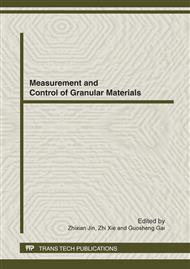[1]
Starch industry Report. The eleventh five-year-plan of starch industry in China. Information on http: /www. siacn. org/NewsView. asp?ID=168&SortID=25, (2007).
Google Scholar
[2]
H.Y. Xie: maize starch explosion at QinHuangDao LiHua Starch Co., LTD., Information on http: /www. chinanews. com/gn/news/2010/02-25/2139532. shtml, (2010).
Google Scholar
[3]
S.A. Abbasi: Dust explosions-Cases, causes, consequences, and control, J Hazard Mater, 140 (2007) 7-44.
Google Scholar
[4]
K.N. Palmer: Dust Explosions and Fire. London: Chapman & Hall, (1973).
Google Scholar
[5]
S. Maiti, S. Dey, S. Purakayastha, B. Ghosh: Physical and thermochemical characterization of rice husk char as a potential biomass energy source, Bioresource Technol 97 (2006) 2065–(2070).
DOI: 10.1016/j.biortech.2005.10.005
Google Scholar
[6]
Y.Q. Tiana, Y. Li, X.M. Xu, Z.Y. Jin: Starch retrogradation studied by thermogravimetric analysis(TGA). Carbohyd Polym, 84 (2011) 1165–1168.
DOI: 10.1016/j.carbpol.2011.01.006
Google Scholar
[7]
E. Rudnik, G. Matuschek, N. Milanov, A. Kettrup: Thermal properties of starch succinates. Thermochim Acta, 427 (2005) 163–166.
DOI: 10.1016/j.tca.2004.09.006
Google Scholar
[8]
X.L. Wang, K.K. Yang, Y.Z. Wang, B. Wu, Y. Liu, B. Yang: Thermogravimetric analysis of the decomposition of poly(1, 4-dioxan-2-one)starch blends, Polym Degrad and Stabil, 81 (2003) 415–421.
DOI: 10.1016/s0141-3910(03)00126-5
Google Scholar
[9]
W.M. Peng, Q.Y. Wu, P.G. Tu, N.M. Zhao: Pyrolytic characteristics of microalgae as renewable energy source determined by thermogravimetric analysis[J], Bioresource Technol, 80 (2001) 1-7.
DOI: 10.1016/s0960-8524(01)00072-4
Google Scholar
[10]
J. Wang, G.C. Wang, M.X. Zhang, M.Q. Chen, D.M. Li, F.F. Min, M.G. Chen, S.P. Zhang, Z.W. Ren, Y.J. Yan: A comparative study of thermolysis characteristics and kinetics of seaweeds and fir wood. Process Biochem, 41 (2006) 1883–1886.
DOI: 10.1016/j.procbio.2006.03.018
Google Scholar
[11]
J. Wang: Experimental investigation and numerical simulation of grain dust explosion. Northeastern University. 2010, pp.49-50.
Google Scholar
[12]
A. Kumar, L.J. Wang, Y.A. Dzenis, D.D. Jones, M.A. Hanna: Thermogravimetric characterization of corn stover as gasification and pyrolysis feedstock. Biomass bioenerg, 32 (2008) 460 – 467.
DOI: 10.1016/j.biombioe.2007.11.004
Google Scholar
[13]
K.G. Mansaray, A.E. Ghaly: Determination of kinetic parameters of rice husks in oxygen using thermogravimetric analysis. Biomass Bioenerg, 17 (1999) 19- 31.
DOI: 10.1016/s0961-9534(99)00022-7
Google Scholar


